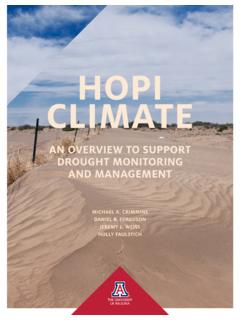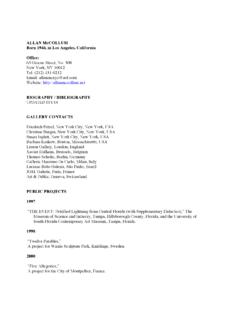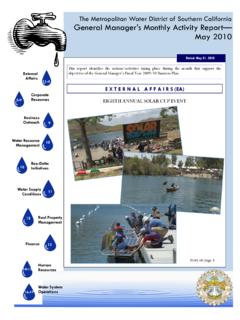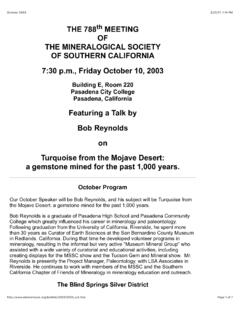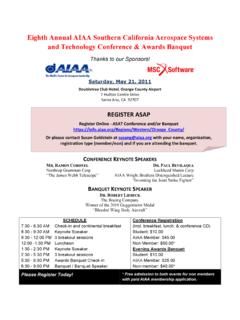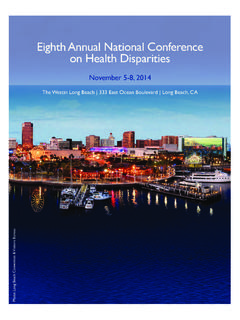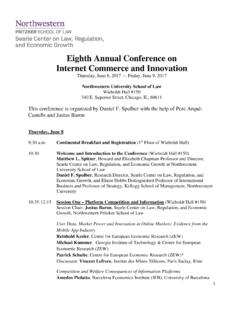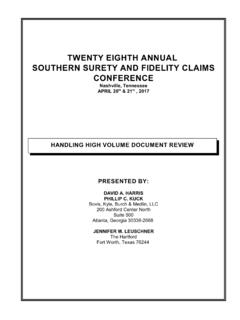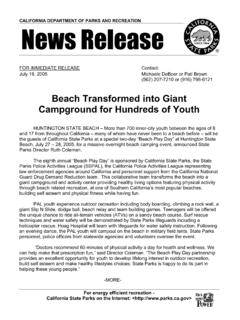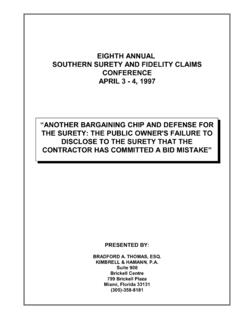Transcription of 2010 National Seasonal Assessment Workshop for the …
1 2010 National Seasonal Assessment Workshop for the Western States and Alaska On April 20-22, 2010 fire, weather and climate specialists convened at the National Oceanic and Atmospheric Administration Earth System Research Laboratory in Boulder, Colorado for the eighth annual National Seasonal Assessment Workshop . A forecast of Seasonal significant fire potential for the western states and Alaska was produced. This briefing document includes a description of existing climate forecasts, fuels conditions, and influences on resource requirements. Significant Fire Potential Forecast (May August 2010) The map below shows the significant fire potential forecast for May through August 2010 across the western half of the and Alaska. Significant fire potential is defined as the likelihood that a wildland fire event will require mobilization of additional resources from outside the area in which the fire situation originates.
2 Areas highlighted as Above Normal are likely to require additional external resource mobilization. The Workshop results indicate there will be above normal significant fire potential across portions of the Northwest, Northern Rockies, Rocky Mountains, northern Great Basin, northeastern california , southern Arizona and leeward side of the Hawaiian Islands. Below normal significant fire potential is forecast for portions of southern california , the Great Basin, and the Southwest. Elsewhere, significant fire potential is expected to be normal through August. The critical factors influencing significant fire potential for this outlook period are: Drought: Drought conditions continue to persist over northeast california and northwest Nevada, western Wyoming, western Montana and much of Idaho. Snowpack: Snowpack in the Southwest has been well above average, while in western Wyoming through the northern Rockies the snowpack has been well below average.
3 Grassland Fuels: Abundant fine fuels across southern Arizona are expected to lead to an active 4-6 week grassland fire season. Fine fuels are not expected to be of concern in the Great Basin. There is an increased large fire risk over the california desert areas in June due to fine fuels, with fire potential decreasing to normal by July. Fire Season Onset: In areas with above average snowpack, fire season onset will be delayed due to a later snowpack melt. Southwest Monsoon: Early indications suggest monsoon onset will occur around the typical start date or later with associated precipitation amounts near normal for the season. Climate Conditions and Forecasts A moderate to strong El Ni o has been in place during the last 12 months. The January - March precipitation anomaly pattern across the West had a classic El Ni o look with above average precipitation in the Southwest and dry in the Northwest and northern states.
4 Consensus forecasts of sea surface temperatures suggest decreasing equatorial Pacific temperatures to neutral conditions through summer. The National Weather Service Climate Prediction Center s outlooks reflect some lingering El Ni o effects through the May time-frame. Beyond May, climate outlooks are influenced by a combination of soil moisture conditions, model output, and long term climate trends. Temperature and Precipitation Snowpack, roughly south of a line from Reno to Denver, has been near or above average while locations further north have been below average. Soil moisture anomalies are below average for much of the northwest quarter of the country. This pattern is reflected in the Drought Monitor. The NOAA Climate Prediction Center (CPC) Seasonal outlooks for May through July and June through August 2010 (at left) predict above average temperatures across most of the West and Alaska.
5 The greatest likelihood of above average temperatures is in Arizona and southern Nevada during May through July, and the Arizona / Utah / Nevada area during June through August. During May through July, CPC indicates increased chances for dryness across the Northwest, northern Idaho and western Montana during June through August. Geographic Area Discussions Alaska: Significant fire potential is expected to start above average in May, then transition to normal by June for the remainder of the fire season. Therefore, significant fire potential is expected to be normal for the overall May through August time period. Below normal winter snowpack over much of Alaska and anticipated developing drought over the central and southern interior will contribute to lower than normal fuel moistures.
6 Forecasts for May through August call for above normal temperatures, especially early in the season, and near normal precipitation. This will likely increase fire activity early in the fire season and perhaps bring an early start to fire season. In general, historic fire occurrence has shown that years with similar spring climate and fuels conditions, and anticipated summer climate conditions, compared to 2010 have resulted in normal fire activity for Alaska. Therefore, fire activity is anticipated to become closer to near average as the season progresses. Confidence in the outlook for Alaska is moderate. Northwest: Above normal significant fire potential is forecast for extreme northern and eastern Washington and extreme southern Oregon. Normal significant fire potential is expected elsewhere.
7 Snowpack across the Northwest as of late April was running on average 50-75% of normal. Most El Ni o winters are followed by a warmer and drier than normal May, which is in line with the May forecast for 2010. This would lead to an earlier than normal snowmelt and accelerated drying of fuels. Fire season is anticipated to begin one to two weeks earlier than normal in the Northwest and consequently lead to a longer than average fire season. Forecasts for June through August are for warmer and drier than normal conditions. These conditions could produce active fires should sufficient ignition triggers materialize. The predicted summer climate pattern may lean towards lightning activity in Okanogan region of north-central Washington and therefore a higher likelihood of significant fire potential. Elsewhere, some spikes in large fire activity are expected during the summer fire season, especially in the drier regions of southeastern Washington and south-central Oregon.
8 Confidence in the outlook for the Northwest is moderate. california and Hawaii: Above normal significant fire potential is forecast for northeast california for May through August. southern california is forecast to have above normal significant fire potential for the deserts in May into early June, then transitioning to below normal significant fire potential for portions of the central Sierra Nevada and the central coast for June through August. Above normal significant fire potential is forecast for the leeward side of the Hawaiian Islands. Normal significant fire potential is expected elsewhere. Although much of california received abundant precipitation over the winter, northeastern california continues to experience drought conditions that are forecast to persist throughout the summer. This will contribute to lower fuel moistures and fire danger indices as the season progresses.
9 Damage to trees from winter storms will add to the downed fuel load in some locations across the state. Forecasts for May through August call for warmer than normal temperatures and near normal precipitation, except possibly drier than normal in extreme northern california . Winter and spring precipitation has resulted in copious fine fuels across the deserts of southern california . This area will likely see above normal significant fire potential early in the fire season. In general across southern california , fire season is expected to begin on time at the lower elevations (below 3,000 feet) and late across elevations above 5,000 feet. Below normal risk of large fires is anticipated over the central coast and portions of the central Sierra Nevada where persistent winter and spring weather patterns have brought plentiful precipitation.
10 Long term drought is expected to persist along the leeward side of the Hawaiian Islands through the summer. Confidence in the outlook for california and Hawaii is moderate to high. Northern Rockies: Above normal significant fire potential is expected west of the Great Divide with normal significant fire potential expected elsewhere. Moderate to severe drought has developed west of the Divide due to below normal fall precipitation and winter snowpack. Drought is forecast to persist across this area with anticipated warmer and drier than normal summer conditions. However, unlike recent years with active fire seasons across the Northern Rockies, the current drought is short term beginning last December. Snowmelt is anticipated to occur early this year due to low snowpack levels and above normal May temperatures. This will likely lead to an accelerated drying of fuels and a possible early start to the fire season.

